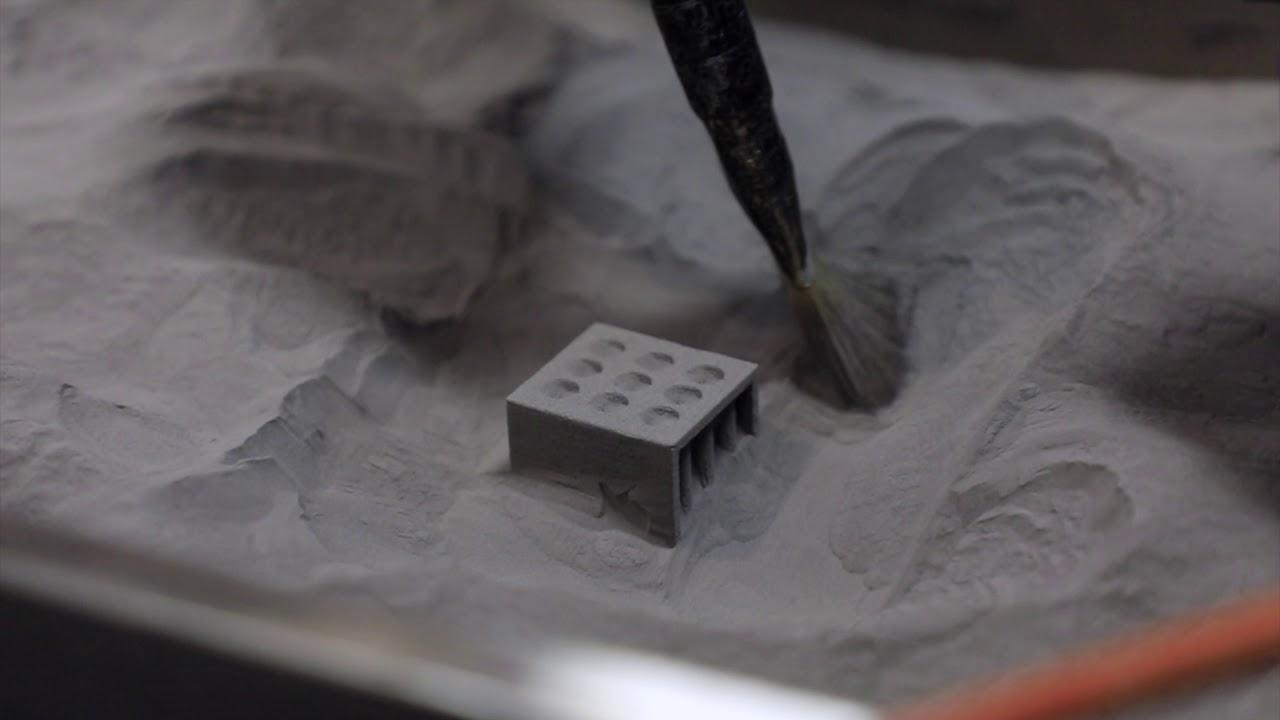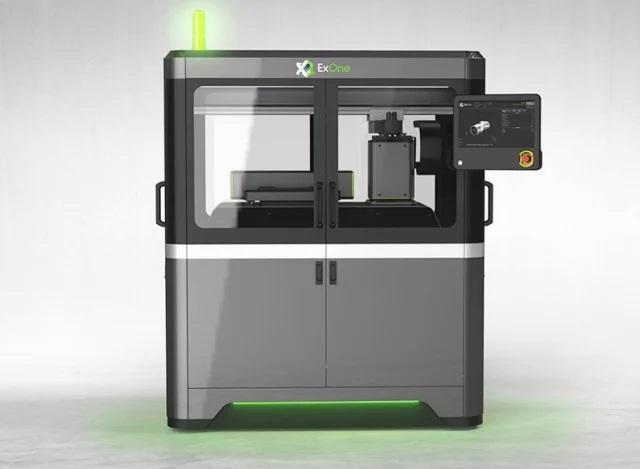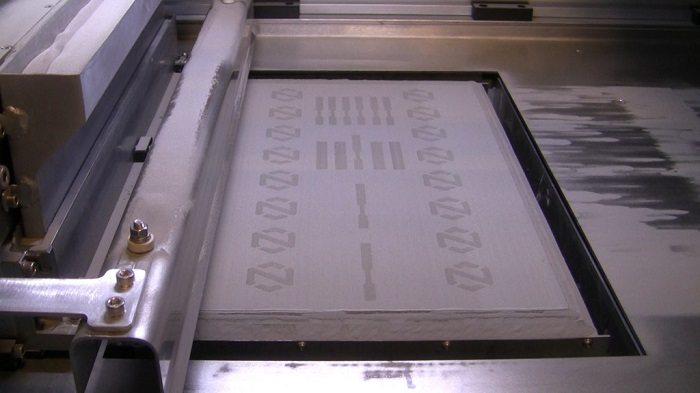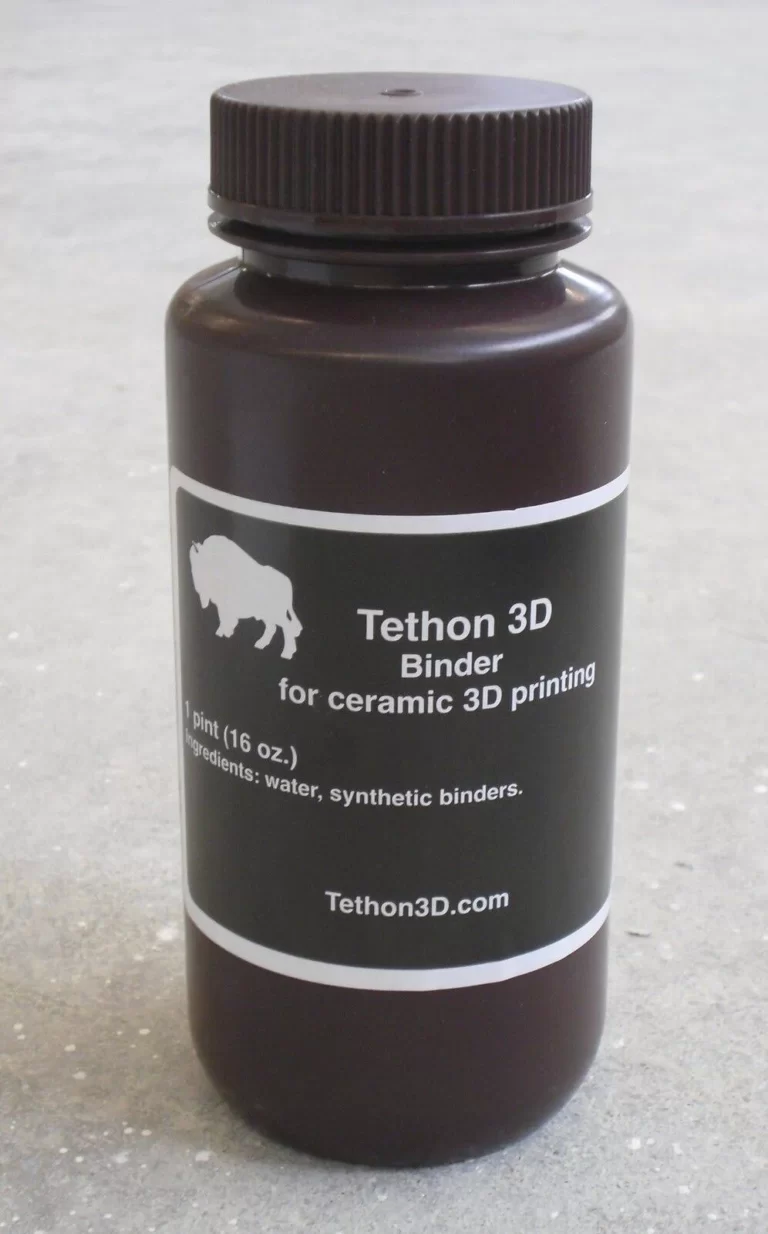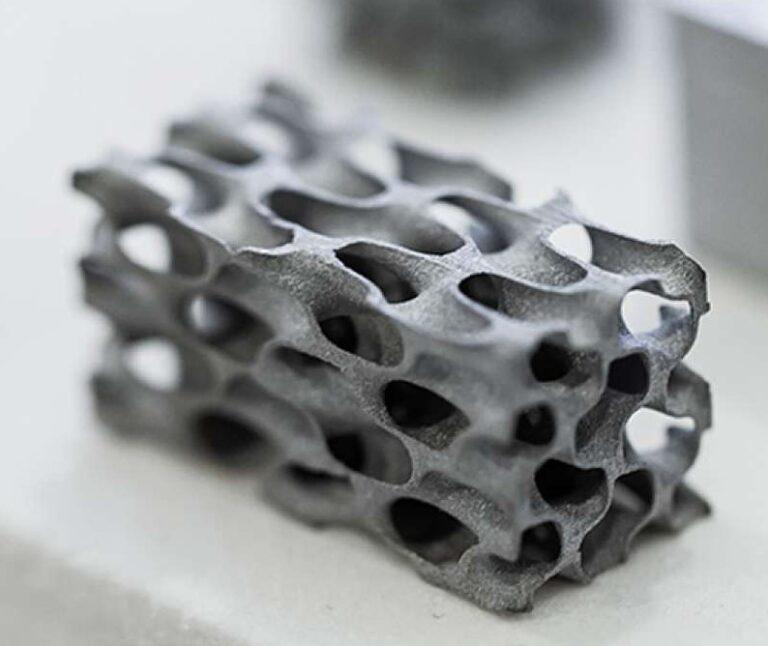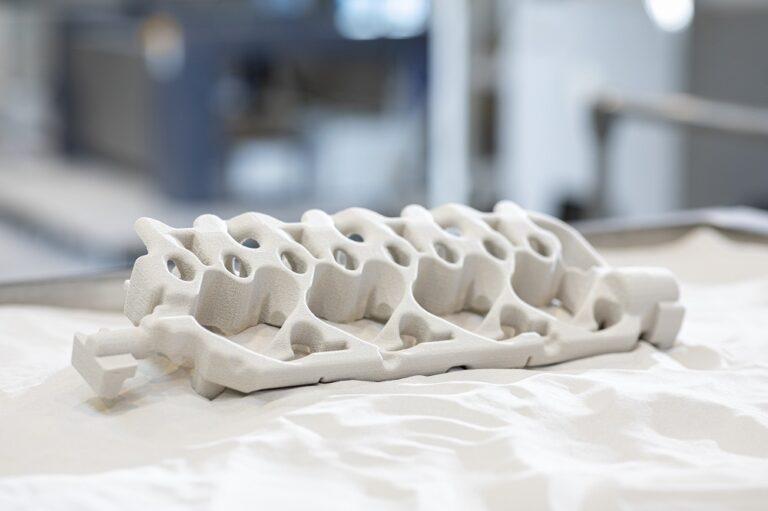Introduction
Are the most recent developments in 3D printing technology of interest to you? Do you know anything about Binder Jet 3D printing? A fast-developing technology that can potentially transform the manufacturing sector entirely is BJ 3D printing. This technology may produce complex components and structures at a fraction of the cost and time of conventional manufacturing techniques. In this blog article, we’ll go into binder jet 3D printing and examine its potential as the future of manufacturing with affordable solutions. Keep reading to discover more about this fascinating technology. Whether you’re a professional in the field, an enthusiast, or just curious!

what is Binder Jet 3D Printing?
Binder Jet 3D Printing is an additive manufacturing technology. It fuses powdered materials into a solid object using a liquid binding agent. Firstly, it spreads a layer of powder across a build platform. Then, it selectively deposits a liquid binding agent on the powder layer. It binds the powder particles in the desired pattern. This process repeats until the object is complete. Binder Jet 3D Printing is a versatile technology. It can produce parts and structures with different properties and applications, using various materials, such as metals, ceramics, and composites. Compared to traditional manufacturing methods, BJ 3D Printing is cost-effective and faster, making it an attractive option for industrial-scale production.
Brief history
Researchers at the Massachusetts Institute of Technology (MIT) developed Binder Jet 3D Printing technology over two decades ago. In 2003, the company ExOne introduced the first commercial Binder Jet 3D Printing machine based on this research and development. Initially, the technology was used mainly for prototyping and model-making purposes. However, it has since evolved into a technology capable of producing functional parts and structures. Over time, Binder Jet 3D Printing has become increasingly cost-effective, and its material range has expanded. Today, various industries use Binder Jet 3D Printing. These industries include aerospace, automotive, and medical. They utilize it for producing high-quality parts and structures in less time and cost than traditional manufacturing methods.
development of Binder Jet 3D Printing technology
Binder Jet 3D Printing technology has significantly developed since its inception. It has improved its capabilities and expanded the range of materials that can be used. Initially, the technology allowed printing with only a few materials, such as sand and plaster. However, recent developments have expanded the range of materials to include metals, ceramics, and composites. The printing resolution has also improved, enabling the production of high-precision parts and structures. Printing software advances have made it easier to design and print complex geometries, further expanding the technology’s potential applications. Moreover, the technology has become suitable for large-scale manufacturing. The size of the parts that can be printed has increased. These developments have made Binder Jet 3D Printing a viable alternative to traditional manufacturing methods in many applications.
cost-effective solutions for manufacturing
This blog post focuses on exploring how Binder Jet 3D Printing can offer cost-effective solutions for manufacturing. Traditional manufacturing methods, such as injection molding or casting, can be expensive and time-consuming, especially for small production runs. Binder Jet 3D Printing can produce parts and structures with significantly reduced costs and lead times. This is especially beneficial for complex geometries. Binder Jet 3D Printing uses inexpensive raw materials. The printing process is fast and efficient. This makes it an attractive option for industrial-scale production. This blog post explores the advantages of Binder Jet 3D Printing. It focuses on the cost-effectiveness of the technology. Binder Jet 3D Printing makes manufacturing more accessible to a broader range of industries and businesses.
How Binder Jet 3D Printing Works
Binder Jet 3D Printing is an intriguing technique. It is gradually gaining acceptance in the manufacturing sector. It can generate intricate components and structures swiftly and affordably. But how precisely does it work? We will discuss Binder Jet 3D Printing in this section. We will explore the various stages involved in the process. We’ll go through the various parts of a Binder Jet 3D Printer. We will discuss the required materials for Binder Jet 3D Printing. We’ll explore the different methods used to produce products using this technology.
Overview of the Binder Jet 3D Printing process
In the Binder Jet 3D Printing process, the printer creates a solid object layer by layer through several steps. First, the printer spreads a layer of powder material evenly across a build platform. The printer then selectively deposits a liquid binding agent. The binding agent is deposited onto the powder layer. The powder particles are bound together in the desired pattern. This process repeats layer by layer until the object is complete. After printing, a post-processing stage removes excess powder and sinters the object to improve its strength and durability. Binder Jet 3D Printing uses various materials, including metals, ceramics, and composites, to produce parts with different properties and applications. Binder Jet 3D Printing is highly efficient and cost-effective. It is suitable for creating complex parts and structures. It has applications in various industries.
Materials used in Binder Jet 3D Printing
Designers can use various materials such as metals, ceramics, polymers, and composites in Binder Jet 3D printing. Powdered materials provide greater flexibility in creating the final product. The binding agent used in the printing process depends on the material. Solvent-based binding agents are commonly used with metals and ceramics. Water-based agents are typically used with materials like sand or gypsum. Affordable and easily accessible raw materials are used in Binder Jet 3D Printing. This helps to reduce the overall cost of the production process. Thus, it becomes an ideal solution for various industries. These industries include aerospace and medical devices.
Metals
Binder Jet 3D Printing can use a variety of metal powders, including stainless steel, titanium, and aluminum. Metal parts produced using this technology are typically strong, with excellent mechanical properties. The final parts undergo a sintering process to remove the excess binder and fuse the metal particles. The result is a high-quality, finished metal part ideal for various applications, including aerospace, automotive, and medical devices.
Ceramics
Binder Jet 3D Printing can also use various ceramic materials, including alumina, zirconia, and silica. Binder Jet 3D Printing creates dense ceramic parts. The mechanical properties of these parts are excellent. They can be used for biomedical implants and electronic components. The final parts sinter to remove the excess binder and fuse the ceramic particles, producing a high-quality, finished ceramic part.
Polymers
Binder Jet 3D Printing can use a variety of polymer powders, including nylon, polypropylene, and ABS. Binder Jet 3D Printing can produce polymer parts. These parts are lightweight and have excellent mechanical properties. They are suitable for various applications, from automotive to consumer goods. The final parts go through post-processing. Post-processing stage removes excess binder. The part is sintered during post-processing. Sintering improves the part’s strength and durability.
Composites
Binder Jet 3D Printing can use composite materials. Composite materials are made of a combination of different materials. Materials include carbon fiber and epoxy resin. Binder Jet 3D Printing produces composite parts. These parts are typically lightweight and strong. They are ideal for applications such as aerospace and automotive. The final parts undergo a post-processing stage that involves removing excess binder and sintering the part to improve its strength and durability.
How Binder Jet 3D Printing differs from other 3D printing technologies
Binder Jet 3D Printing differs from other 3D printing technologies in several ways. One key difference is how it builds objects layer by layer. Binder Jet 3D Printing does not melt or cure materials to build up layers. Fused Deposition Modeling (FDM) and Stereolithography (SLA) do. Binder Jet 3D Printing selectively deposits a liquid binding agent onto a powder bed. This process binds the particles together to form layers. This makes it more efficient for printing complex objects with intricate geometries, as it does not require support structures.
Binder Jet 3D Printing can also use various materials, including metals and ceramics, making it suitable for multiple industrial applications. Another advantage of Binder Jet 3D Printing is its scalability. This technology can produce large objects quickly and cost-effectively, making it an ideal solution for manufacturing applications. Overall, Binder Jet 3D Printing is a versatile and cost-effective technology offering unique benefits compared to other 3D printing technologies.
Fused Deposition Modeling (FDM)
FDM is a popular 3D printing method that melts a plastic filament and deposits it layer by layer to create an object. While FDM is easy to use and widely available, it has limitations regarding the materials it can use and the surface quality of the finished object. Additionally, FDM often requires support structures that must be removed after printing, which can be time-consuming and difficult. In comparison, Binder Jet 3D Printing can use a wide range of materials, including metals and ceramics, and does not require support structures, making it a more versatile and efficient technology for producing complex objects.
Stereolithography (SLA)
SLA is another popular 3D printing method that uses a laser or UV light to cure a liquid resin into a solid object layer by layer. While SLA can produce high-quality, detailed objects with smooth surfaces, it has limitations regarding the size and the range of materials it can use. Additionally, SLA can be expensive and time-consuming due to the need for post-processing to remove excess resin and cure the final object. In comparison, Binder Jet 3D Printing can produce large objects quickly and cost-effectively. It can use a wide range of materials, making it a more versatile and cost-effective technology for industrial applications.
Selective Laser Sintering (SLS)
SLS is a 3D printing method that uses a laser to selectively sinter a powdered material, typically nylon, into a solid object layer by layer. While SLS can produce high-quality, strong objects with complex geometries, it has limitations regarding the range of materials it can use and the object’s size. Additionally, SLS can be expensive due to the need for specialized equipment and materials. In comparison, Binder Jet 3D Printing can use a broader range of materials, including metals and ceramics. It can produce larger objects more efficiently, making it a more versatile and cost-effective technology for industrial applications.
Advantages of Binder Jet 3D Printing
The industrial sector has been completely transformed by the new technique known as Binder Jet 3D Printing. It provides unique advantages compared to other 3D printing technologies and conventional production techniques. In this part, we’ll look into Binder Jet 3D Printing’s benefits, from affordability to design adaptability, and how they make it the perfect choice for various industrial applications. Binder Jet 3D Printing can revolutionize your company, whether you’re trying to lower production costs, enhance the performance of your products, or increase the efficiency of your supply chain. Let’s explore the various benefits of this cutting-edge technology now.
Cost-effectiveness
One of the most significant advantages of Binder Jet 3D Printing is its cost-effectiveness. Compared to traditional manufacturing methods, such as injection moulding or CNC machining, Binder Jet 3D Printing can reduce production costs significantly. The technology uses less material and faster production time, resulting in lower material and labor costs. Moreover, Binder Jet 3D Printing can create complex geometries and parts with fewer manufacturing steps, reducing costs. Because it is affordable, Binder Jet 3D printing is a good choice for small and medium-sized businesses that want to cut costs and improve their bottom line.
Speed
Binder Jet 3D Printing is a fast and efficient manufacturing technology that can significantly speed up production. Compared to traditional manufacturing methods, Binder Jet 3D Printing requires fewer steps and can produce parts in hours rather than days or weeks. The technology’s speed also allows for rapid prototyping, enabling engineers and designers to test quickly and iterate designs before committing to mass production. Additionally, the speed of Binder Jet 3D Printing can reduce lead times, allowing companies to respond rapidly to changes in demand or supply chain disruptions. This speed advantage makes Binder Jet 3D Printing an attractive option for companies looking to accelerate manufacturing processes and improve their competitiveness in the marketplace.
Design flexibility
The versatility of Binder Jet 3D printing’s designs is another important benefit. Thanks to technology, complex forms and patterns that would be challenging or impossible to construct using conventional manufacturing techniques may now be produced. Because Binder Jet 3D Printing can print sophisticated geometries and features layer by layer, it can be flexible. Additionally, the method enables the use of various substances, such as metals, ceramics, and polymers, each of which has distinct qualities that might improve the finished product’s performance. Since complicated forms and designs are essential for product performance and innovation in aerospace, automotive, and medicine sectors, Binder Jet 3D Printing is a desirable alternative.
Scalability
Binder Jet 3D Printing technique allows for scalability, making it suitable for both small-scale and large-scale production. It can produce high-quality parts in large quantities, making it ideal for prototyping and low-volume production runs. The technology’s capacity for batch manufacturing of parts reduces production time and increases productivity, enabling companies to rapidly and efficiently scale up production without sacrificing quality or design. Additionally, it can be used to create unique components for each batch, reducing waste and inventory expenses. In summary, Binder Jet 3D Printing is an attractive option for companies seeking to increase production quickly and effectively, while maintaining high-quality standards and design flexibility.
Applications of Binder Jet 3D Printing
Cutting-edge technology called Binder Jet 3D Printing has given the industrial sector new opportunities. Due to its distinct benefits, including speed, cost-effectiveness, design flexibility, and scalability, it is the perfect answer for various industrial applications. This section will examine the numerous uses of Binder Jet 3D printing, including those in aerospace, automotive, medicine, and consumer products. We’ll also investigate how businesses utilize this technology to enhance production methods and develop cutting-edge goods. Binder Jet 3D Printing can completely change your company, regardless of your goals for cost savings, manufacturing speed, or product performance. So let’s dig in and learn about the innovative applications of this technology.
Industrial manufacturing: use binder jet for mass production of parts
Binder Jet 3D Printing is revolutionizing the industrial manufacturing industry as an increasingly popular solution for mass-producing parts. Industries such as automotive and aerospace are utilizing Binder Jet 3D Printing to create engine components and lightweight structural parts because it can produce high-quality parts in large quantities quickly and affordably. For example, Ford Motor Company collaborated with ExOne to create Binder Jet 3D Printing technology for the mass production of automobile components such as brake rotors and engine parts. This partnership has led to shorter production lead times and significant cost savings. Binder Jet 3D Printing has the potential to transform the industrial sector by creating intricate forms and shapes, providing new opportunities for the mass production of high-quality components.
Aerospace and automotive industries: use Binder Jet to produce lightweight, high-strength parts
The automobile and aerospace sectors use Binder Jet 3D Printing to create lightweight, high-strength parts. The technology is perfect for complex forms and patterns that would be challenging or impossible to make using conventional production techniques. In the aerospace sector, manufacturers use Binder Jet 3D Printing to create turbine blades for aircraft engines, which must be light and robust to resist the harsh conditions of flight. In the automobile sector, the technique is used to make parts such as engine components, suspension systems, and brake calipers, which demand great strength and precision. Ford Motor Company is using Binder Jet 3D Printing actively to produce metal brake parts for its Shelby GT500, reducing the weight of the parts by over 50% compared to traditional manufacturing methods, thereby improving the vehicle’s performance and reducing fuel consumption and emissions.
Medical industry: use Binder Jet 3D Printing to create custom implants and prosthetics
The medical industry has been one of the early adopters of Binder Jet 3D Printing technology. This is due to the technology’s ability to create custom implants and prosthetics that fit a patient’s unique anatomy. With Binder Jet 3D Printing, medical professionals can produce implants that match a patient’s exact measurements, reducing the risk of complications and improving postoperative outcomes. For example, Binder Jet 3D Printing to create custom titanium implants for patients with chest wall tumours reduced the overall treatment time and improved patient outcomes compared to traditional manufacturing methods.
Another example of how Binder Jet 3D Printing is being used in the medical industry is the production of dental implants. Dental implants replace missing teeth and can be customized to fit the patient’s mouth perfectly. Binder Jet, 3D Printing technology, can create complex dental implant shapes with high accuracy and precision. In a recent application, Binder Jet 3D Printing produced dental implants with a porous structure that could promote bone growth and osseointegration. It showed that using Binder Jet 3D Printing resulted in high-quality biocompatible implants that perfectly fit the patient’s mouth. This demonstrates how Binder Jet 3D Printing is improving not only patient outcomes in the medical industry but also in the dental industry.
Challenges and Limitations of Binder Jet 3D Printing
While Binder Jet 3D Printing has numerous advantages, like any other technology, it also faces challenges and limitations. In this section, we will discuss the challenges and constraints of Binder Jet 3D Printing. Understanding these limitations is essential, as they can impact the decision to adopt the technology in specific applications. By acknowledging these challenges and limitations, we can better understand the potential of the technology and work towards finding solutions to overcome these limitations. Let’s explore the challenges and constraints of Binder Jet 3D Printing in more detail.
Current limitations in the size and complexity of objects
Binder Jet 3D Printing currently has a limitation in terms of the size and complexity of objects that it can print. The printer’s build volume sets the maximum size of objects that can be printed. Most Binder Jet 3D printers have a relatively small build volume, which restricts the size of objects that can be produced. Additionally, the printing of intricate and complex geometries may not be feasible as the process requires adding support structures to the object during printing.
Removing these support structures can be challenging, which can limit the complexity of the object that can be printed. Despite these limitations, Binder Jet 3D Printing has demonstrated its potential in various industrial applications, and researchers are working to overcome these limitations. For example, they are developing ways to print large objects by printing them in smaller sections and then assembling them. Others are developing new materials that can be printed more easily with Binder Jet 3D Printing.
overcoming the size limitation
ExOne’s Innovent Pro overcomes the size limitation of Binder Jet 3D Printing. Users can print large objects by breaking them down into smaller sections and assembling them. The printer achieves this using a “build and bind” approach. It prints a section of the object and then applies a binder material to the surface of the printed section to create a temporary adhesive bond.
The printer applies the binder material to the newly printed section, creating a bond between the two sections, and then continues to print the next section of the object. Users can print larger objects than the printer’s build volume by repeating this process until the entire object is printed in smaller, easily assembled sections. This approach is a practical solution to overcome the size limitation of Binder Jet 3D Printing.
Material limitations
The variety of materials that may be utilized is one of Binder Jet 3D Printing’s key constraints, although technology has made great strides in recent years. The materials currently printed using binder jet 3D technology are mostly metal and ceramic powders that can be bonded together. This implies that Binder Jet 3D Printing cannot utilize other materials like plastics. Furthermore, Binder Jet 3D Printing’s material characteristics may be constrained, especially compared to other 3D printing methods. For instance, Binder Jet 3D Printing components may have different mechanical strength or thermal characteristics than parts created using different ways, which may restrict their usefulness for particular applications. Because of this, material restrictions continue to be a significant obstacle for Binder Jet 3D Printing. Continued research and development efforts are required to increase the variety of materials that may be utilized and enhance the characteristics of already-existing materials.
Binder Jet 3D Printing imposes material restrictions that limit the creation of car components. Although it has the potential to reduce the cost and time required to manufacture complex parts like engine blocks, the range of materials that can be used is currently restricted. This makes it challenging to produce parts that meet the mechanical and thermal requirements of the automotive industry. For example, conventional manufacturing techniques produce stronger and more durable engine components compared to Binder Jet 3D Printing. Therefore, further research and development are necessary to overcome the existing material limits and produce components with the necessary qualities, although Binder Jet 3D Printing has the potential to revolutionize the automotive industry.
Quality control issues
Ensuring quality control is maintained consistently throughout the production process is one of the difficulties of utilizing Binder Jet 3D Printing. Variations in material qualities, ambient conditions, and printing settings can all affect the end product’s quality, just as with any manufacturing process. Furthermore, the use of powders in Binder Jet 3D Printing might pose a challenge in ensuring uniform deposition of each layer, which could result in flaws in the final product. Quality control problems can be critical in sectors like aerospace or medicine, where goods must adhere to tight regulatory standards. Businesses utilizing Binder Jet 3D Printing must spend money on quality control procedures and tools to guarantee that each printed component adheres to the necessary standards to overcome these difficulties.
The aerospace sector offers a case study of Binder Jet 3D Printing quality control problems. Aerospace items created via 3D printing must adhere to strict performance and safety standards. The parts’ mechanical qualities must be reliable and consistent as one such criterion. However, because of the intrinsic unpredictability of the powder bed, Binder Jet 3D Printing can create components with anisotropic qualities, which can result in variations in the mechanical performance of the finished product. Aerospace businesses that use Binder Jet 3D Printing have created quality control procedures to solve this problem, which entails testing and analysis to ensure that each produced item complies with the necessary standards. Processes, including post-processing inspections, testing of mechanical qualities, and in-process monitoring of powder quality and deposition, are all possible.
Conclusion
We hope that by the time you conclude this blog article, you have a better grasp of how Binder Jet 3D Printing technology has the potential to revolutionize the industrial sector. We have looked at the benefits of this technology, including its speed, scalability, and flexibility in terms of design. But some issues and restrictions must be resolved, just as with any new technology. In this concluding part, we will recap the main ideas covered in this blog article and offer some closing views on the potential of binder jet 3D printing.
Recap of the advantages and applications
In this blog article, we have explored the benefits of Binder Jet 3D Printing, which include its affordability, design adaptability, speed, and scalability. We also explored how aerospace, automotive, and medical industries use this technology, and how Binder Jet 3D Printing has the potential to revolutionize the manufacturing industry by offering a faster and more efficient production process and allowing for the creation of complex shapes and designs. Additionally, personalized implants and prostheses in the medical sector have demonstrated encouraging outcomes. However, to overcome obstacles and constraints such as material limitations, quality control issues, and current size and complexity restrictions, we need to develop solutions. Binder Jet 3D Printing is a promising innovation that will advance and influence production in the future.
Prediction of future developments and improvements in Binder Jet 3D Printing technology
Like any cutting-edge technology, experts anticipate that Binder Jet 3D Printing will continue to develop and improve in the future. Analysts predict that the technology will become more affordable, opening up new markets and uses. Furthermore, researchers expect advancements in software and materials to increase the flexibility and accuracy of the design. Some experts are even investigating more advanced printing techniques that could lead to the production of sophisticated, multifaceted objects. As experts continue to develop the technology, they expect to discover even more impressive applications and use cases, which will make Binder Jet 3D Printing an increasingly exciting and valuable manufacturing solution.
Using new materials may be one example of future breakthroughs and enhancements in Binder Jet 3D Printing technology. Although the range of materials that can be produced with Binder Jet 3D printing is currently constrained, research is being done to increase this range. For instance, recent research has looked into using biodegradable and bio-based materials in Binder Jet 3D Printing, which has intriguing potential uses in the medical and environmental sectors.
Additionally, improvements in software and hardware technologies could make it possible to print with greater accuracy, efficiency, complexity, and intricacy. This may create even more complex and unique designs, such as specialized medical implants and elaborate architectural models.
Overall, it will be intriguing to watch where Binder Jet 3D Printing technology goes in the future as it continues to grow and improve. It has enormous promise for a variety of sectors and applications.
Consider Binder Jet 3D Printing for Cost-Effective Manufacturing Solutions
As we’ve seen throughout this blog article, Binder Jet 3D Printing has several unique advantages for the industrial sector, including speed, cost-effectiveness, and design freedom. Binder Jet 3D Printing is a technique you should consider if you’re searching for methods to lower your manufacturing costs, enhance the quality of your products, or simplify your supply chain. No matter what sector you operate in—automotive, aerospace, medical, or any other—Binder Jet 3D Printing can probably help you meet your production objectives. Don’t be afraid to investigate this cutting-edge technology and learn how your company might benefit from it in various ways.
FAQs
A variety of materials can be used in Binder Jet 3D Printing, including metals, ceramics, polymers, and composites. Some common examples include stainless steel, bronze, nylon, and sandstone.
Yes, Binder Jet 3D Printing can be used for both small-scale and large-scale production. This technology is particularly well-suited for low- to medium-volume production runs, as it offers cost-effective and flexible manufacturing solutions.
Some of the challenges of Binder Jet 3D Printing include limitations in the size and complexity of objects that can be printed, material limitations, and quality control issues. However, ongoing developments in the technology are likely to address many of these challenges and further expand the range of applications for Binder Jet 3D Printing.

